The Bloodhound, with its incredibly keen sense of smell, has been responsible for helping law enforcement agencies solve countless cases over the years. Its exceptional tracking abilities are just one part of what makes this breed so remarkable.
The Bloodhound's gentle and affectionate nature, combined with its loyalty and devotion, make it an ideal companion for families and individuals alike. From its origins in Belgium to its impressive size and lifespan, there is much to explore about this ultimate tracking and companion dog.
If you're curious to learn more about the Bloodhound's behavioral considerations, exercise needs, health concerns, and compatibility with children and other pets, this discussion will provide valuable insights into this remarkable breed.
Key Takeaways
- Bloodhounds are gentle and affectionate dogs with a calm and patient nature.
- They are outstanding trackers and search and rescue dogs, making them excellent companions for outdoor activities.
- Bloodhounds are independent thinkers and require consistent and patient training.
- Early socialization is vital for well-rounded adult Bloodhounds, and responsible breeders provide health clearances for their parents to ensure their overall well-being.
Origin and Size
The Bloodhound, a large and noble breed, originated in Belgium and is known for its impressive size. Adult males typically stand between 23-27 inches at the shoulder, while females range from 21-25 inches. In terms of weight, males can weigh between 80-110 pounds, while females typically weigh 70-90 pounds.
This breed falls under the Hound group and has a lifespan of about 10-12 years. Bloodhounds are renowned for their exceptional tracking abilities and are often used in search and rescue operations. They've a gentle and affectionate personality, coupled with a calm and patient nature. Their loyalty and devotion to their owners are remarkable.
However, due to their independent thinking, consistent and patient training is necessary.
Lifespan and Breed Group
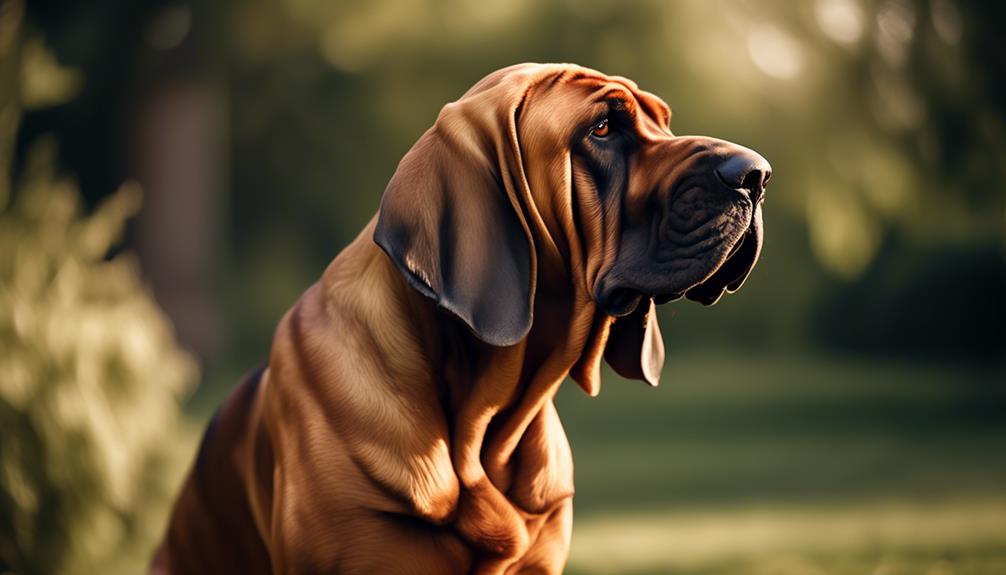
Bloodhounds have an average lifespan of 10-12 years and belong to the Hound breed group. These dogs are known for their remarkable tracking abilities and make excellent companions. To provide a quick overview of the Bloodhound breed, here is a table highlighting some key information:
| Lifespan | Breed Group |
|---|---|
| 10-12 years | Hound |
Bloodhounds have a lifespan that falls within the average range for most dog breeds. They are categorized as part of the Hound breed group, which is known for its excellent scenting and tracking abilities. This breed group includes other popular breeds such as the Beagle and the Dachshund. The Bloodhound's lifespan and breed group are important factors to consider when deciding if this breed is the right fit for you and your family.
Adaptability and Apartment Living

Adapting well to apartment living, Bloodhounds are a breed that thrives in a compact living space. Despite their large size, Bloodhounds have qualities that make them suitable for apartment living.
Here are three reasons why Bloodhounds are adaptable in apartments:
- Quiet and low-energy: Bloodhounds are known for their calm and patient nature, making them less likely to bark excessively or exhibit high energy levels indoors.
- Good manners towards neighbors: Bloodhounds are gentle and affectionate dogs, making it easier for them to interact politely with neighbors and other residents.
- Size doesn't matter: Although Bloodhounds are large, their low-energy and quiet nature means that they don't require a lot of space to roam around. As long as they receive regular exercise and mental stimulation, Bloodhounds can adapt well to apartment living.
Behavioral Considerations
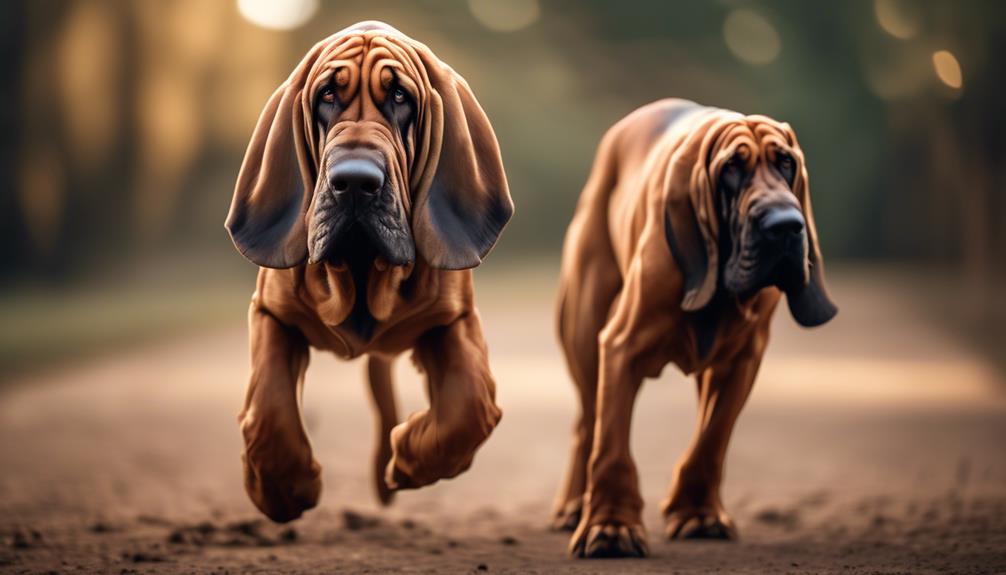
When considering the behavioral aspects of Bloodhounds, it is important to understand the role that fear and anxiety play in aggression. Many cases of aggression in dogs, including Bloodhounds, are rooted in fear and anxiety. Aggression born out of fear and anxiety is common in these dogs. It is crucial for owners to recognize and address these underlying emotions to prevent aggressive behavior. Bloodhounds are generally known for their gentle and affectionate personality, but they can become aggressive if they feel threatened or scared. Proper socialization, training, and a calm and patient approach are essential to help them overcome their fears and exhibit more balanced behavior. Below is a table highlighting the key points related to the behavioral considerations of Bloodhounds:
| Behavioral Considerations of Bloodhounds |
|---|
| Fear and anxiety can lead to aggression |
| Proper socialization and training are crucial |
| Calm and patient approach is important |
| Gentle and affectionate personality |
| Addressing underlying emotions is necessary |
| Recognize and prevent aggressive behavior |
Exercise and Playfulness
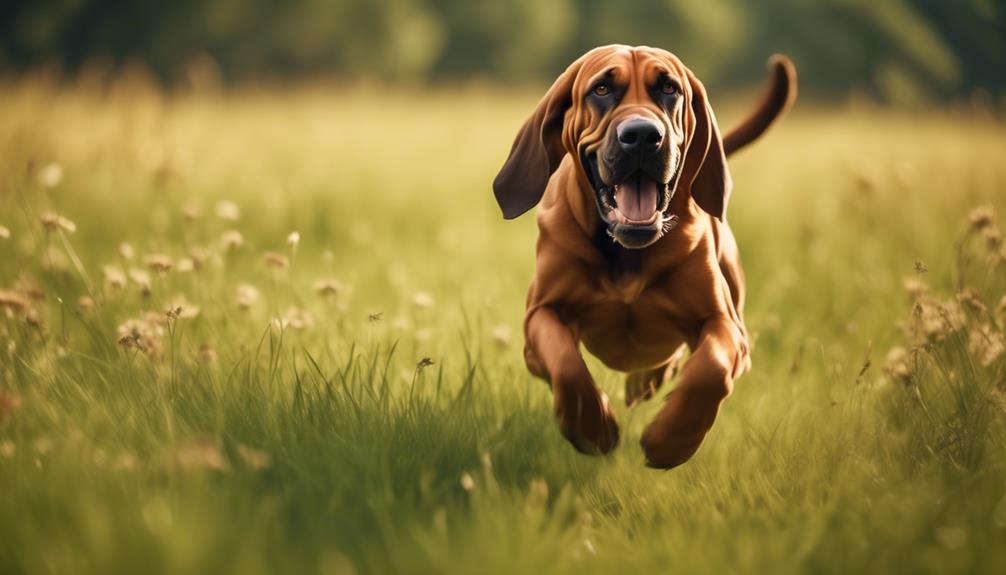
To ensure a healthy and happy Bloodhound, regular exercise and playtime are essential. These energetic and playful dogs require physical and mental stimulation to keep them engaged and content.
Here are three key points to consider when it comes to exercise and playfulness:
- Energy level varies among different dog breeds. Bloodhounds are known for their high energy levels, which means they need plenty of exercise to burn off energy and stay fit.
- Dogs with high energy levels are more likely to engage in jumping, playing, and exploring. It's important to provide them with opportunities for active play and mental stimulation.
- Playfulness should be considered based on your family dynamics and the presence of other dogs or children. Some Bloodhounds are perpetually playful and may require more attention and interaction.
Bloodhound Specific Information
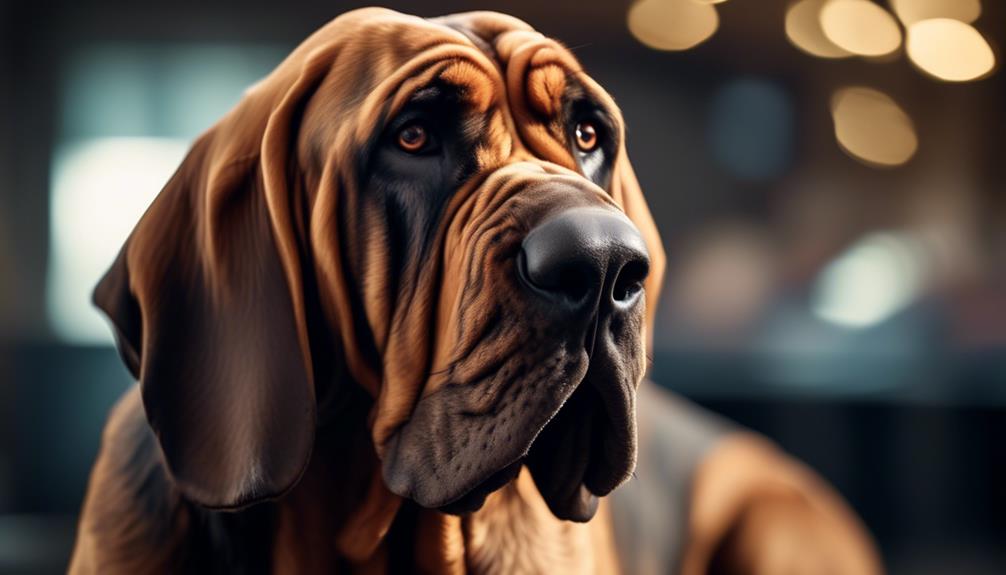
Bloodhounds are well-known for their distinctive appearance and remarkable tracking abilities. Male Bloodhounds typically measure 25-27 inches at the shoulder and weigh between 90-110 pounds, while females measure 23-25 inches and weigh between 80-100 pounds.
They have a gentle and affectionate personality, displaying a calm and patient nature. Bloodhounds are renowned for their outstanding loyalty and devotion, making them excellent companions. They excel as trackers and search and rescue dogs. However, they are independent thinkers and require consistent and patient training.
Their temperament is influenced by genetics, training, and socialization. Bloodhounds are curious and playful, often showing an openness to interacting with people. Opting for a puppy with a balanced disposition is recommended, and early socialization is vital for their development into well-rounded adult dogs.
Bloodhounds may be prone to certain health conditions such as hip and elbow dysplasia, hypothyroidism, and bloat, among others. Regular veterinary check-ups, proper healthcare, and early detection and management of health conditions are essential.
Bloodhounds require large fenced yards and leash training is crucial due to their tendency to wander. Long daily walks are necessary to meet their exercise needs, and exercise should be limited for puppies until they reach physical maturity. Crate training is highly recommended, along with providing chew toys to prevent destructive behavior.
Bloodhounds have a loose and thin coat with deep folds and pendulous skin, and regular brushing and cleaning of wrinkles are necessary to prevent bacterial infections. They have a natural affinity for children, but supervision is important during interactions. Bloodhounds may coexist well with cats, although feline family members may not appreciate their presence.
Care and Maintenance
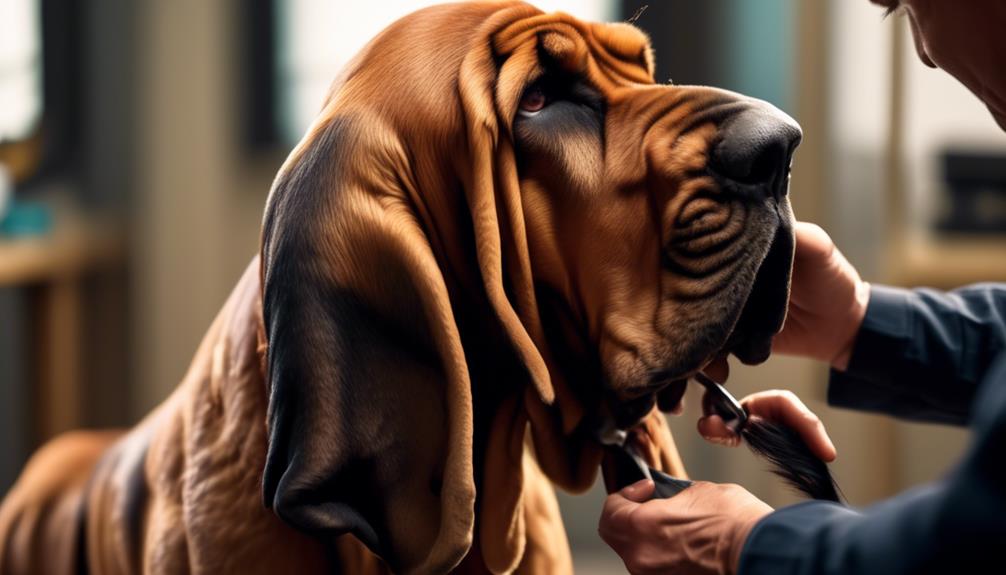
Taking proper care of a Bloodhound involves regular grooming, exercise, and attention to their specific health needs. To ensure their well-being, here are three essential aspects of care and maintenance for Bloodhounds:
- Grooming: Bloodhounds have loose and thin coats with deep folds and pendulous skin. Regular brushing with a rubber hound mitt is recommended to keep their coat healthy. Using a shedding blade during shedding season helps remove excess hair. It's also crucial to clean their wrinkles and flews regularly to prevent bacterial infections.
- Exercise: Bloodhounds are known for their excellent endurance and are great for outdoor activities. They require long daily walks and plenty of interaction. However, it's important to limit exercise for Bloodhound puppies until they reach physical maturity. Following the rule of 5 minutes of exercise per month of age helps prevent strain on their growing bodies.
- Health needs: Bloodhounds are prone to certain health conditions such as hip and elbow dysplasia, hypothyroidism, and gastric dilatation-volvulus. Regular veterinary check-ups and proper healthcare are essential for early detection and management of these conditions. Additionally, providing a balanced diet with high-quality food, measuring portions, and considering factors like bloat and gastric torsion are crucial for their overall health.
Frequently Asked Questions
What Is the History and Origin of the Bloodhound Breed?
The history and origin of the Bloodhound breed can be traced back to Belgium. These dogs are known for their remarkable tracking abilities and make loyal companions. They have a gentle and affectionate personality, but also require consistent and patient training.
Are Bloodhounds Suitable for Families With Young Children?
Yes, Bloodhounds are suitable for families with young children. They have a gentle and affectionate personality, and they are known to coexist well with children. However, interactions should always be supervised to ensure safety.
Do Bloodhounds Get Along Well With Other Pets, Such as Cats?
Bloodhounds generally get along well with other pets, including cats. However, it's important to supervise interactions and introduce them slowly. Each individual dog's personality and socialization play a role in their compatibility with other animals.
How Do I Properly Groom and Care for a Bloodhound's Unique Coat?
To properly groom and care for a Bloodhound's unique coat, regular brushing with a rubber hound mitt is recommended. Shedding blades can be used during shedding season, and wrinkles and flews should be cleaned regularly to prevent infections.
Are There Any Specific Health Concerns or Conditions That Bloodhounds Are Prone To?
Bloodhounds are prone to health conditions such as hip and elbow dysplasia, hypothyroidism, ectropion, entropion, epilepsy, bloat, and fold dermatitis. Responsible breeders provide health clearances and regular veterinary check-ups are important for early detection and management.
Are Bloodhounds and Blue Lacys Good Companions for Tracking and Hunting?
Bloodhounds and Blue Lacys are exceptional companions for tracking and hunting. The Bloodhound’s keen sense of smell and the spirited Blue Lacy canine companion‘s agility make them a perfect team. Their loyalty and determination make them ideal partners for any hunting or tracking expedition.
Conclusion
In conclusion, the Bloodhound is truly the ultimate tracking and companion dog. Their remarkable tracking skills, gentle demeanor, and loyalty make them a valuable asset in search and rescue operations.
While their large size and energy levels may require ample exercise and mental stimulation, their calm and patient nature make them ideal family pets. Despite any concerns about their size or energy, the Bloodhound's affectionate personality and devotion to their owners will surely win over the hearts of any dog lover.




